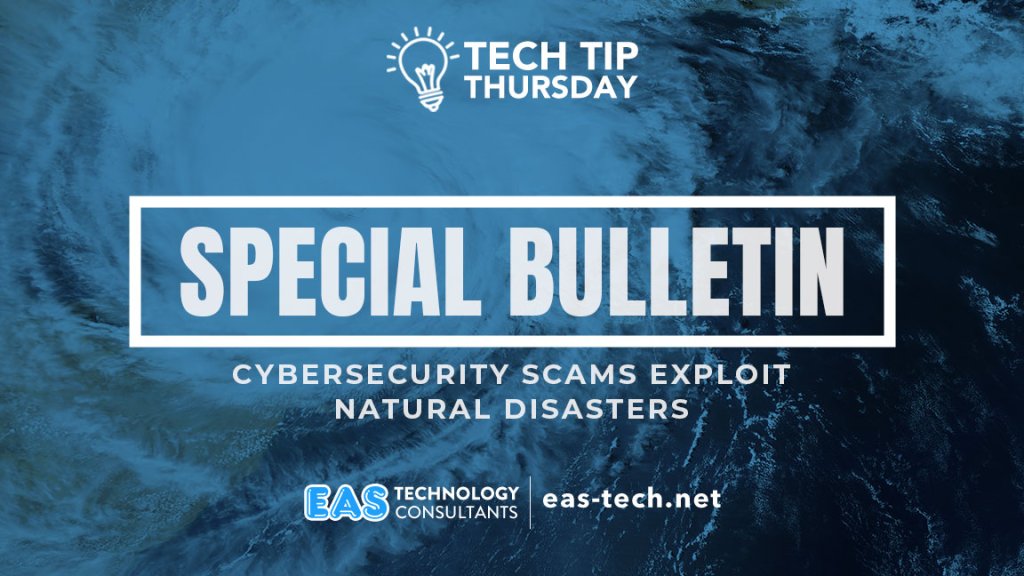
Natural disasters are harrowing events that can wreak havoc on communities, leaving behind destruction, despair, and a sense of vulnerability. In the midst of these crises, the last thing anyone needs is to fall victim to a cybersecurity scam. Unfortunately, cyber attackers are quick to seize the opportunity presented by natural disasters, using social engineering tactics, techniques, and procedures (TTPs) to target disaster victims and concerned citizens. This article sheds light on the dangers of cybersecurity scams related to natural disasters, the strategies used by attackers, and how you can protect yourself and your community.
The Perfect Storm for Cyber Scammers
Natural disasters like hurricanes bring chaos, confusion, and a surge in online activity as people seek information, assistance, and ways to help. It is precisely during these turbulent times that cybercriminals find the perfect cover for their malicious activities. Here’s how they do it:
- Phishing Attacks: Cyber attackers often send deceptive emails and text messages that appear to come from legitimate sources, such as government agencies, charities, or disaster relief organizations. These messages request personal information, financial donations, or encourage recipients to click on malicious links.
- Malware Distribution: Scammers embed malware in fake disaster relief apps, websites, or attachments, claiming they provide critical information or assistance. When users download these malicious files or click on links, they unwittingly infect their devices.
- Impersonation and Charity Scams: Attackers may impersonate disaster relief organizations, creating fake websites and social media profiles to collect donations. These scams divert funds away from genuine relief efforts and into the pockets of criminals.
- Emotional Manipulation: Cyber scammers are adept at exploiting heightened emotions during disasters. They use fear, urgency, and empathy to trick victims into revealing personal information or making hasty decisions.
- Disinformation Campaigns: Some attackers disseminate false information about the disaster, exacerbating panic and confusion. This disinformation can be used to steer victims toward malicious websites or drive them to take actions that benefit the attackers.
The Human Element: Social Engineering
Social engineering is at the heart of these cyber scams. It is the art of manipulating individuals into divulging confidential information or performing actions that compromise their security. Attackers capitalize on the emotional vulnerability of disaster victims and concerned citizens, using the following techniques:
- Urgency and Fear: Scammers create a sense of urgency, often by claiming that immediate action is needed to protect oneself or loved ones. Victims are less likely to question the authenticity of a message when they believe there is a time-sensitive emergency.
- Trust Building: Attackers may impersonate trusted entities, like government agencies or reputable charities. By mimicking official logos and using official-sounding language, they gain the trust of their victims.
- Emotional Appeal: Cybercriminals play on victims’ emotions, making them feel sympathetic to the cause. They use heart-wrenching stories and images to elicit empathy and encourage donations.
- Manipulative Language: Scammers employ persuasive language, often mixing facts with falsehoods, to confuse and deceive their targets. They may also resort to threats to scare victims into compliance.
Protecting Yourself and Your Community
In the face of these threats, it’s essential to remain vigilant and take proactive measures to protect yourself and your community during natural disasters:
- Verify Information: Always verify the authenticity of messages, websites, and organizations before taking any action. Cross-reference information with trusted sources such as official government websites or established charities.
- Don’t Click on Suspicious Links: Avoid clicking on links in unsolicited emails or messages. Instead, visit websites directly by typing their URLs into your browser.
- Beware of Emotional Manipulation: Be cautious if a message or request plays on your emotions, especially if it seems excessively urgent or relies heavily on emotional appeals.
- Use Reliable Channels: Rely on official government websites, emergency alert systems, and well-known charity websites when seeking information or making donations.
- Keep Software Updated: Regularly update your device’s operating system and security software to protect against malware.
- Educate Others: Share information about cybersecurity scams with your friends, family, and community to raise awareness and prevent others from falling victim.
Natural disasters are challenging enough without the added burden of cybersecurity scams. Cybercriminals often use social engineering tactics to exploit the vulnerability of disaster victims and concerned citizens. By staying informed, cautious, and vigilant, we can collectively work to protect ourselves and our communities from falling victim to these deceptive schemes. In times of crisis, let us remember that unity and resilience extend to our online defenses as well, ensuring that we weather the storm both physically and digitally.
